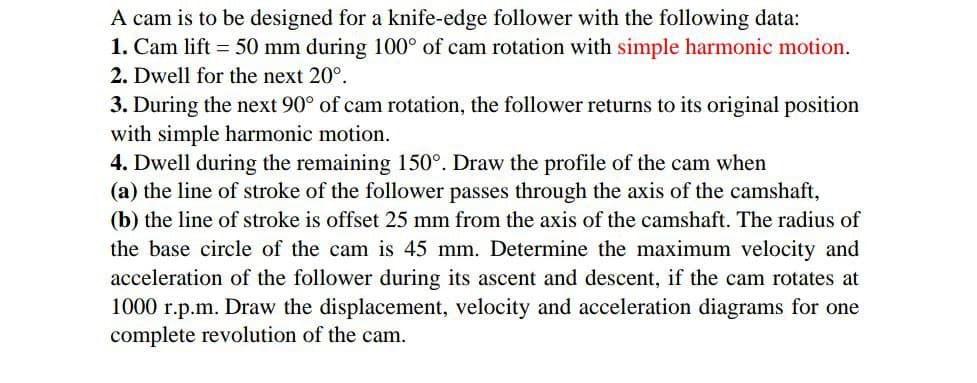m is to be designed for a knife-edge follower with the following data: m lift 50 mm during 100° of cam rotation with simple harmonic motion. vell for the next 20°. iring the next 90° of cam rotation, the follower returns to its original position simple harmonic motion. well during the remaining 150°. Draw the profile of the cam when he line of stroke of the follower passes through the axis of the camshaft, he line of stroke is offset 25 mm from the axis of the camshaft. The radius of pase circle of the cam is 45 mm. Determine the maximum velocity and oroti of the follow or during its oscont ond doscont if tho com roto of
m is to be designed for a knife-edge follower with the following data: m lift 50 mm during 100° of cam rotation with simple harmonic motion. vell for the next 20°. iring the next 90° of cam rotation, the follower returns to its original position simple harmonic motion. well during the remaining 150°. Draw the profile of the cam when he line of stroke of the follower passes through the axis of the camshaft, he line of stroke is offset 25 mm from the axis of the camshaft. The radius of pase circle of the cam is 45 mm. Determine the maximum velocity and oroti of the follow or during its oscont ond doscont if tho com roto of
Elements Of Electromagnetics
7th Edition
ISBN:9780190698614
Author:Sadiku, Matthew N. O.
Publisher:Sadiku, Matthew N. O.
ChapterMA: Math Assessment
Section: Chapter Questions
Problem 1.1MA
Related questions
Question

Transcribed Image Text:A cam is to be designed for a knife-edge follower with the following data:
1. Cam lift = 50 mm during 100° of cam rotation with simple harmonic motion.
2. Dwell for the next 20°.
3. During the next 90° of cam rotation, the follower returns to its original position
with simple harmonic motion.
4. Dwell during the remaining 150°. Draw the profile of the cam when
(a) the line of stroke of the follower passes through the axis of the camshaft,
(b) the line of stroke is offset 25 mm from the axis of the camshaft. The radius of
the base circle of the cam is 45 mm. Determine the maximum velocity and
acceleration of the follower during its ascent and descent, if the cam rotates at
1000 r.p.m. Draw the displacement, velocity and acceleration diagrams for one
complete revolution of the cam.
Expert Solution
This question has been solved!
Explore an expertly crafted, step-by-step solution for a thorough understanding of key concepts.
Step by step
Solved in 2 steps with 2 images

Knowledge Booster
Learn more about
Need a deep-dive on the concept behind this application? Look no further. Learn more about this topic, mechanical-engineering and related others by exploring similar questions and additional content below.Recommended textbooks for you

Elements Of Electromagnetics
Mechanical Engineering
ISBN:
9780190698614
Author:
Sadiku, Matthew N. O.
Publisher:
Oxford University Press

Mechanics of Materials (10th Edition)
Mechanical Engineering
ISBN:
9780134319650
Author:
Russell C. Hibbeler
Publisher:
PEARSON

Thermodynamics: An Engineering Approach
Mechanical Engineering
ISBN:
9781259822674
Author:
Yunus A. Cengel Dr., Michael A. Boles
Publisher:
McGraw-Hill Education

Elements Of Electromagnetics
Mechanical Engineering
ISBN:
9780190698614
Author:
Sadiku, Matthew N. O.
Publisher:
Oxford University Press

Mechanics of Materials (10th Edition)
Mechanical Engineering
ISBN:
9780134319650
Author:
Russell C. Hibbeler
Publisher:
PEARSON

Thermodynamics: An Engineering Approach
Mechanical Engineering
ISBN:
9781259822674
Author:
Yunus A. Cengel Dr., Michael A. Boles
Publisher:
McGraw-Hill Education

Control Systems Engineering
Mechanical Engineering
ISBN:
9781118170519
Author:
Norman S. Nise
Publisher:
WILEY

Mechanics of Materials (MindTap Course List)
Mechanical Engineering
ISBN:
9781337093347
Author:
Barry J. Goodno, James M. Gere
Publisher:
Cengage Learning

Engineering Mechanics: Statics
Mechanical Engineering
ISBN:
9781118807330
Author:
James L. Meriam, L. G. Kraige, J. N. Bolton
Publisher:
WILEY